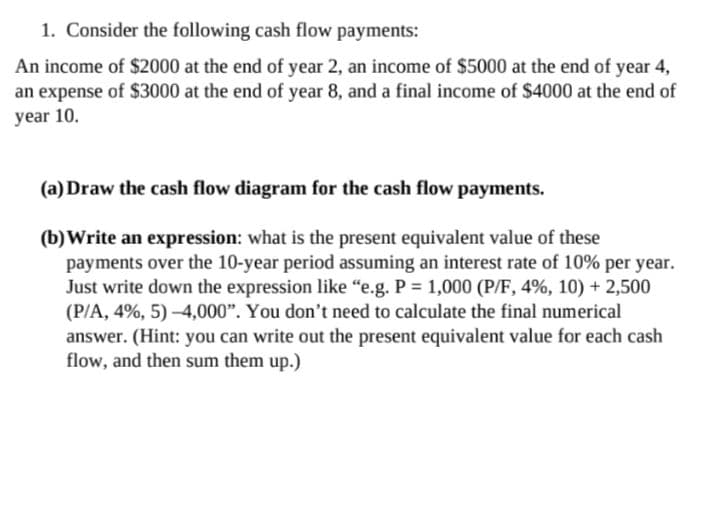1. Consider the following cash flow payments: An income of $2000 at the end of year 2, an income of $5000 at the end of year 4, an expense of $3000 at the end of year 8, and a final income of $4000 at the end of year 10. (a) Draw the cash flow diagram for the cash flow payments. (b) Write an expression: what is the present equivalent value of these payments over the 10-year period assuming an interest rate of 10% per year. Just write down the expression like "e.g. P = 1,000 (P/F, 4%, 10) + 2,500 (P/A, 4%, 5)-4,000". You don't need to calculate the final numerical answer. (Hint: you can write out the present equivalent value for each cash flow, and then sum them up.)
1. Consider the following cash flow payments: An income of $2000 at the end of year 2, an income of $5000 at the end of year 4, an expense of $3000 at the end of year 8, and a final income of $4000 at the end of year 10. (a) Draw the cash flow diagram for the cash flow payments. (b) Write an expression: what is the present equivalent value of these payments over the 10-year period assuming an interest rate of 10% per year. Just write down the expression like "e.g. P = 1,000 (P/F, 4%, 10) + 2,500 (P/A, 4%, 5)-4,000". You don't need to calculate the final numerical answer. (Hint: you can write out the present equivalent value for each cash flow, and then sum them up.)
Cornerstones of Cost Management (Cornerstones Series)
4th Edition
ISBN:9781305970663
Author:Don R. Hansen, Maryanne M. Mowen
Publisher:Don R. Hansen, Maryanne M. Mowen
Chapter19: Capital Investment
Section: Chapter Questions
Problem 22E
Related questions
Question

Transcribed Image Text:1. Consider the following cash flow payments:
An income of $2000 at the end of year 2, an income of $5000 at the end of year 4,
an expense of $3000 at the end of year 8, and a final income of $4000 at the end of
year 10.
(a) Draw the cash flow diagram for the cash flow payments.
(b) Write an expression: what is the present equivalent value of these
payments over the 10-year period assuming an interest rate of 10% per year.
Just write down the expression like "e.g. P = 1,000 (P/F, 4%, 10) + 2,500
(P/A, 4%, 5)-4,000". You don't need to calculate the final numerical
answer. (Hint: you can write out the present equivalent value for each cash
flow, and then sum them up.)
Expert Solution
This question has been solved!
Explore an expertly crafted, step-by-step solution for a thorough understanding of key concepts.
Step by step
Solved in 3 steps with 1 images

Knowledge Booster
Learn more about
Need a deep-dive on the concept behind this application? Look no further. Learn more about this topic, accounting and related others by exploring similar questions and additional content below.Recommended textbooks for you

Cornerstones of Cost Management (Cornerstones Ser…
Accounting
ISBN:
9781305970663
Author:
Don R. Hansen, Maryanne M. Mowen
Publisher:
Cengage Learning

Principles of Accounting Volume 2
Accounting
ISBN:
9781947172609
Author:
OpenStax
Publisher:
OpenStax College


Cornerstones of Cost Management (Cornerstones Ser…
Accounting
ISBN:
9781305970663
Author:
Don R. Hansen, Maryanne M. Mowen
Publisher:
Cengage Learning

Principles of Accounting Volume 2
Accounting
ISBN:
9781947172609
Author:
OpenStax
Publisher:
OpenStax College



Financial And Managerial Accounting
Accounting
ISBN:
9781337902663
Author:
WARREN, Carl S.
Publisher:
Cengage Learning,

Managerial Accounting
Accounting
ISBN:
9781337912020
Author:
Carl Warren, Ph.d. Cma William B. Tayler
Publisher:
South-Western College Pub